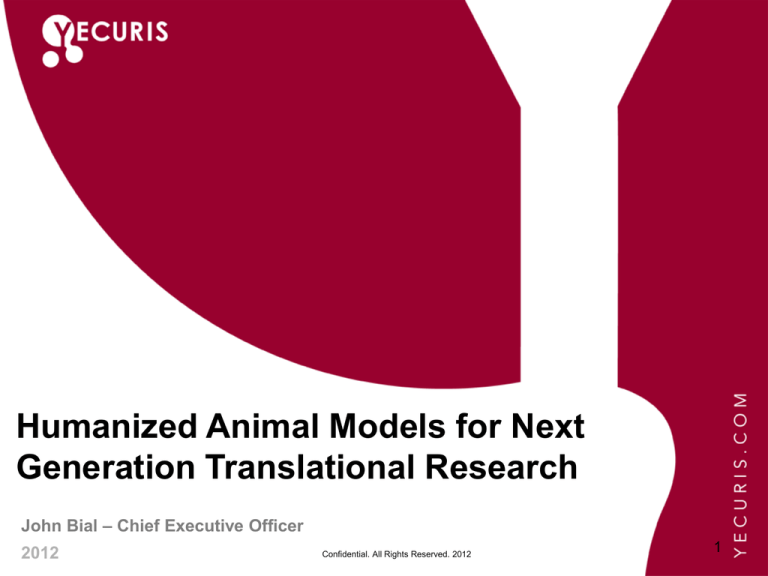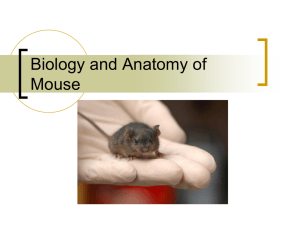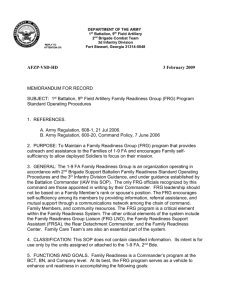
Humanized Animal Models for Next
Generation Translational Research
John Bial – Chief Executive Officer
2012
Confidential. All Rights Reserved. 2012
1
Humanized Animal Models
Humanized Models
Quasi-Humanized Models
Transgenic, knockout, or otherwise
suppressed systems that allow for primary
human cell xenografts
Transgenic, knockout, or otherwise
suppressed systems that mimic human
processes, but do not contain primary
human cells
YecurisTM FRGTM KO Model
CXR/Taconic transADMETTM Model
2
A Brief History of Humanized Mice
Quasi-Humanized
Humanized
•
•
•
•
Alb/uPA Transgenic
Controllable FAH-/- KO
Repop uPA
Repop FAH-/-
- Heckel
- Grompe
- Rhim
- Grompe
•
Hu uPA/SCID / HCV
- Mercer
•
•
Hu uPA/SCID / Metabolism - Tateno
Hu uPA/SCID / Validation - Katoh
•
Hu FRGTM / Metabolism
- Azuma
•
Hu FRGTM / HCV
- Bissig
•
Hu uPA/SCID / 3A4 DDI
- Hasegawa
•
Hu
FRGNTM
/ L/B Malaria
- Vaughan
1990
1995
2000
2005
2010
2012
•
•
2D6(+) + HNF4α(-)
Intestinal 3A4
•
Liver 3A4
Herwaarden
3a(-), 3A4(+)
•
•
•
•
•
- Corchero
- Granvil
- van
- van Herwaarden
3a(-), 3A4(+)
- van
CAR/PXR
- Sheer
Waterschoot
3a(-)/3a13(+)/3A4/3A7 and
CAR/PXR/3A4/3A7 DDI
2d6(-),
2D6 Variants
- Sheer
Hasegawa
3
Why Chimeric Systems?
Comparison of Spend vs. Output
“If you do what you’ve always done,
you’ll get what you’ve always gotten.”
- Tony Robbins
60
50
40
30
20
10
0
1
•
Drugs are failing in new and increasingly
creative ways
•
Drugs are failing late in the process
•
•
Traditional tools are useful, but gaps are
forming
New tools must be more physiologically
relevant, be more predictive, and on net
reduce costs
3
5
7
9
11 13 15 17 19 21 23 25 27 29
PhRMA R&D Spend ($B)
Approved NME's
Failure by Type, Phase III
Commerc
Other,
ial, 7%
6%
Safety,
21%
Efficacy,
66%
4
Chimeric Tools in Preclinical Development
Early Tox
Screening
Clearance
Uni-Dimensional
•
•
•
•
•
Efflux
Drug-Drug
Interactions
Toxicology
-
Clinic
Metabolite
ID
Induction /
Inhibition
Genotox
Immunotox
Reprotox
Systems Biology
Primary Cell Bioreactors
Rate Determination for Low Clearance Drugs
Identification of Human Specific Metabolism
Species Specific Toxicology
ADME/Tox in Disease Model Context
• Data Continuity
• Increasingly
Translational
5
Yecuris Corporation Founded in 2007 by Markus Grompe
Location: Portland, Oregon
Products and Property
-
Primary Human Hepatocytes
FRG on C57Bl/6
FRG on NOD
FAH Rat and Pig
Company Aim: To create a method of culturing high quality
human hepatocytes and other primary cells for use in cell
therapy applications utilizing animal bioreactor technologies.
6
In this presentation:
Part I: Introduction and Background
• Tyrosine catabolic pathway
• The Yecuris FRG/c57 Bl6 mouse
• The Yecuris FRG/NOD mouse
Part II: Liver repopulation with human hepatocytes
• Principals of Humanization
• Characterization of FRG KO Humanized Livers
• Liver Model Comparison
Part III: Application Areas
•
•
•
•
•
In Vitro Cells
Infectious Disease
Safety/Toxicology
Cancer
Stem Cells
7
Part I: Introduction and Background
Tyrosine Catabolic Pathway
Yecuris FRG KO/c57 Bl6 Model
Yecuris FRG KO/NOD Model
8
Tyrosine Catabolic Pathway
Tyrosine
NTBC
TAT
PPD
4Hydroxyphenylpyruvic
Acid
HG
D
Homogentisic Acid
MAI
Maleylacetoacetate
Liver Disease &
Renal Injury
Fumarylacetoacetate
Succinylacetoacetate
Succinylacetone
FAR
HT1
FAH
FAH
Fumarate
Succinate
+
+
Acetoacetate
Acetoacetate
Part I: Introduction and Background
9
Core Technology – The Yecuris FRG Mouse
Yecuris FRG KO/c57 Bl6 mouse contains three mutations:
• FAH knockout induces liver disease
• Rag2 (recombinant activating gene 2) knockout induces
T and B cell deficiency
• Il2rg (Interleukin 2 subunit γ-chain) knockout induces NK
cell deficiency
Part I: Introduction and Background
10
Core Technology – Next Generation Yecuris Models
Yecuris FRG KO/NOD (Beta Testing in Process)
• FAH-/- / Rag2-/- / Il2rg-/• Ability to integrate humanization of liver and immune
systems
• Improved model health and robustness
Part I: Introduction and Background
11
Core Technology – Next Generation Yecuris Models
New Species of Humanized Models
• FRG KO Rat:
• Large single animal cell isolation
• Industry standard species for toxicology studies
• Larger liver and body weight for DMPK studies
• FAH KO in the Pig:
• Hepatocytes for cell therapy and liver assist
• Human liver transplant
Part I: Introduction and Background
12
Part II: Liver Repopulation with Human Hepatocytes
Principles of Humanization
Characterization of FRG KO Humanized Livers
Liver Model Comparison
13
Human Hepatocyte Repopulation in FRG Mice
Cell Engraftment
.5-1M Cells
4 Weeks
1-5M Cells
20-50 μg/mL HSA
>> 1% Liver Repopulation
8 Weeks
5-10M Cells
12+ Weeks
50-150M Cells
200-500 μg/mL HSA
1-5% Liver Repopulation
2000-5000+ μg/mL HSA
20-95% Liver Repopulation
Part II: Liver Repopulation with Human Hepatocytes
14
log2 Scale of Human Albumin vs. Percent Repopulation
Part II: Liver Repopulation with Human Hepatocytes
15
Histology of Various Liver Repopulation Levels
< 2% repopulation
10-20% repopulation
20-30% repopulation
20-30% repopulation
70-80% repopulation
30-50% repopulation
70-80% repopulation
70-80% repopulation
Part II: Liver Repopulation with Human Hepatocytes
16
Integration of Human Hepatocytes into Mouse Liver
Human
hepatocytes
Tertiary structure
Mouse
hepatocytes
• Human cell expansion occurs in an ordered fashion, and does not exhibit invasive growth
characteristics
Part II: Liver Repopulation with Human Hepatocytes
17
Integration of Human Hepatocytes into Mouse Liver
Bile Cannaliculi
Tight Junctions
• Electron Microscopy imaging of both bile duct and tight junctions between human cells in a
human repopulated FRG KO mouse.
Part II: Liver Repopulation with Human Hepatocytes
18
Yecuris Models Span a Wide Range of Donors
Donors by Age and Gender
Females
Males
90
80
70
Donor Age (years)
60
50
40
30
20
10
0
• Yecuris has accumulated a large repertoire of donors that range in age from 5M to 83 years
of age.
Part II: Liver Repopulation with Human Hepatocytes
19
Recapitulation of Genetic Disorders for Studies
Gender
Age
BMI
Banked Cells
Notes
Male
12
UK
Yes
Maple Syrup Urine Disease (MSUD)
Female
25
UK
Yes
Ornithine Transcarbamylase Deficiency
(OTC)
Female
5M
UK
Yes
Carbamoyl Phosphate Synthetase I
Deficiency
• Cryopreserved cells of rare genetic disorders have been archived and are being used to
create new models for rare diseases.
• Custom models are frequently created to meet specific research requirements.
Part II: Liver Repopulation with Human Hepatocytes
20
Comparison of Humanized Mouse Models
Attribute
FRG
uPA/SCID
• Stable transgenic knockout yielding no reversion of mouse cells
• Robust expansion of hepatocytes of all ages
• Ability to easily serially transplant and expand hepatocytes
• Ability to ship and use models at client sites or third party CRO’s
• Large healthy animals offer improved survivability, increased
serial sampling, and lower cost per data point
Part II: Liver Repopulation with Human Hepatocytes
21
Part III: Application Areas
In Vitro
In Vivo
Infectious Disease
Safety & Toxicology
Stem Cells and Lines
22
Yecuris Model Allows for Serial Expansion
In Vitro
Infectious
Disease
In Vivo
Stem Cells and
Lines
Safety / Toxicity
140%
140%
140%
120%
120%
120%
100%
100%
100%
80%
80%
80%
60%
60%
60%
40%
40%
40%
20%
20%
20%
0%
0%
1A2
2D6
3A4
0%
1A2
2D6
3A4
1A2
2D6
3A4
120 Donor Data
1° Hepatocyte Activity
1° Hepatocyte Activity
1° Hepatocyte Activity
2° Hepatocyte Activity
3° Hepatocyte Activity
Human Donor
20 Mice
4K Mice
800K Mice
4 Months
4 Months
4 Months
1 Vial
5M Cells
200 Vials
2B Cells
40000 Vials
400B Cells
Part III: Application Areas
8M Vials
80T Cells
23
Humanized Mouse Model Yields High Quality Cells
In Vitro
.25 Day
In Vivo
Infectious
Disease
Safety / Toxicity
7 Days
Stem Cells and
Lines
12 Days
• Cryopreserved human hepatocytes from FRGTM KO mice, plated on collagen, no Percol, no
Matrigel
• 100% of isolations yield plateable cryopreserved cells
Part III: Application Areas
24
Cryopreserved Cells Exhibit Normal Phase II Activity
In Vitro
Infectious
Disease
In Vivo
25
20
15
10
5
1200
pmole/min/million cells
nmole/h/million cells
Donor A
Donor B1
Donor B2
Pool
Stem Cells and
Lines
Transporter Activity
Phase II Dependent Activity
30
Safety / Toxicity
0
Donor A
Donor B1
Pool
1000
800
600
400
200
0
Paracetamol
glucuronidation
activity (1mM)
(UGT1A1, UGT1A6, UGT1A9,
UGT2B15)
Paracetamol
sulfation activity
(1mM)
Estrodiol, 25µM
MPP+, 250µM
Taurocholate,
25µM
(SULT1A1, SULT1A3/4, SULT1E1)
• Cryopreserved human hepatocytes from FRGTM KO mice demonstrate normal transporter
and robust Phase II activity
Part III: Application Areas
25
Hu-FRG KO Mice Express Human-Like Lipid Profiles – In Vivo
In Vitro
Infectious
Disease
In Vivo
Safety / Toxicity
Chloresterol
mmol/L
VLDL (%)
LDL (%)
HDL (%)
LDL/HDL
Ratio
Human
4.7
7.7
57.3
35.1
1.6
Hu-FRG (90%)
1.0
6.2
56.5
37.4
1.5
Hu-FRG (88%)
5.8
1.3
49.9
48.8
1.0
Hu-FRG (45%)
1.9
8.6
43.5
47.9
0.9
FRG KO
5.7
6.6
38.1
55.2
0.7
FRG KO
5.2
1.3
24.5
74.2
0.3
FRG KO
3.9
0.4
22.4
77.1
0.3
Animal
Stem Cells and
Lines
• Serum analysis conducted on control mice versus human cell repopulated FRG mice
Part III: Application Areas
26
Human Apo-E is detected in the serum of Hu-FRG KO Mice
Stem Cells and
Lines
90% Humanized FRG KO
88% Humanized FRG KO
Safety / Toxicity
45% Humanized FRG KO
FRG KO
Human serum Apo E 2/3
Human serum Apo E 3/4
c57Bl6 mouse
FRG KO
Infectious
Disease
In Vivo
ApoE -/- Mouse
In Vitro
human ApoE
mouse ApoE
Part III: Application Areas
27
Hu-FRG KO Mice Express Human-Like Bile Acid Profiles – In Vivo
In Vitro
Infectious
Disease
In Vivo
Safety / Toxicity
Stem Cells and
Lines
Mouse
%
Repopulation
Donor
% T-CA
%G-CA
%CA
T1
94%
1
80.8
8.44
11.07
T2
90%
2
81.5
6.96
11.53
T3
88%
3
87.4
1.5
11.12
T4
78%
4
99.4
0.47
0.08
T5
45%
3
95.7
0.14
4.11
C1
0
NA
99.8
0.17
0.02
C2
0
NA
98.6
0.15
1.30
C3
0
NA
99.4
0.11
0.52
T-CA = Taurine conjugated cholic acid; G-CA = Glycine conjugated cholic acid; CA = total cholic acid
• LC-MS/MS analysis of conjugated cholic acid in the gallbladder bile of human repopulated and
control FRG KO mice.
• Humanized FRG KO mice show glycine conjugation of cholic acid which is human specific.
Part III: Application Areas
28
Case Study 2 – Diclofenac Clearance
In Vitro
Infectious
Disease
In Vivo
Safety / Toxicity
Stem Cells and
Lines
2.5
Concentration (μM)
2
1.5
Diclofenac
1
0.5
0
0
Mouse 7254
100
Mouse 7272
200
Mouse 8502
300
Time (Min)
Mouse 8527
400
Control_1
500
Control_2
600
Human Theoretical
• Diclofenac is more rapidly cleared in humans than in rodents. Chimeric FRG mice
recapitulate this clearance with high reproducibility
Part III: Application Areas
29
Case Study 1 – Lamotrigine Metabolism
Infectious
Disease
In Vivo
Safety / Toxicity
Stem Cells and
Lines
Major Human Metabolite
M3 (N2 Glucuronide)
Lamotrigine
Rag2-/- / Il2rg-/-
WT C57Bl/6
In Vitro
Fah-/- / Rag2-// Il2rg-/-
Routes of Formation: UGT, GST, 2A6 (epoxide)
M8 M3
M2/M7 PM6
M1/M5
Part III: Application Areas
30
Case Study 1 – Lamotrigine Metabolism
Infectious
Disease
In Vivo
Safety / Toxicity
Stem Cells and
Lines
Major Human Metabolite
M3 (N2 Glucuronide)
Lamotrigine
hFRG (50%)
Fah-/- / Rag2-// Il2rg-/-
In Vitro
hFRG (90%)
• At low levels of chimerism, the major
human metabolite is observed in modest
quantities
• At levels of chimerism in excess of
80%, high levels of human metabolite
are observed
M3
P
Part III: Application Areas
31
Case Study 3 – Propafenone Metabolism
In Vitro
In Vivo
Infectious
Disease
Safety / Toxicity
4OH Derivatives
Stem Cells and
Lines
5OH Derivatives
Propafenone
• Propafenone metabolism is 2D6 mediated, and is highly conserved between species. It is
cleared at least an order of magnitude more rapidly by mouse hepatocytes than human.
Part III: Application Areas
32
Case Study 3 – Propafenone Metabolism
In Vitro
Infectious
Disease
In Vivo
Safety / Toxicity
Stem Cells and
Lines
Propafenone
Drug Metab. Pharmacokinet. 25 (3): 223-235 (2010)
16th North American ISSX Meeting, 2009
• Despite efforts by Astellas, Merck, and Phoenix Bio, the 5-hydroxy human metabolite has
never been observed in chimeric models.
Part III: Application Areas
33
Case Study 3 – Propafenone Metabolism
In Vitro
Infectious
Disease
In Vivo
1.6
1.6
1.4
1.4
1.4
1.2
1
0.8
0.6
0.4
1.2
1
0.8
0.6
0.4
0.2
0.2
0
0
100
150
Time (Min)
4-Hydroxy
200
250
300
5-Hydroxy
100
150
Time (Min)
4-Hydroxy
200
5-Hydroxy
250
0.6
0.4
100
150
200
250
300
0
300
5-Hydroxy
50
100
150
Time (Min)
4-Hydroxy
200
100
150
250
200
250
300
250
300
5-Hydroxy
FRG Control Mouse 2
1.6
1.4
1.2
1
0.8
0.6
0.4
0.2
0
0
50
Time (Min)
4-Hydroxy
Mouse 8527 - Donor 2 - hAlb 6.5 mg/mL
Concentration (%Ref)
50
50
Time (Min)
4-Hydroxy
1.6
1.4
1.2
1
0.8
0.6
0.4
0.2
0
0
1
0.8
0
0
Mouse 8502 - Donor 2 - hAlb 5.3 mg/mL
1.2
0.2
Concentration (%Ref)
50
Concentration (%Ref)
1.6
0
Concentration (%Ref)
FRG Control Mouse 1
Mouse 7272 - Donor 1 - hAlb 4.7 mg/L
Concentration (%Ref)
Concentration (%Ref)
Mouse 7254 - Donor 1 - hAlb 5.2 mg/mL
Stem Cells and
Lines
Safety / Toxicity
1.6
1.4
1.2
1
0.8
0.6
0.4
0.2
0
300
5-Hydroxy
0
50
100
150
Time (Min)
4-Hydroxy
200
5-Hydroxy
• 5-hydroxy metabolite is observed in highly chimerized animals, with no observed metabolite
generation in control animals.
Part III: Application Areas
34
FRG as a Model for Hepatitis B and C – In Vivo
In Vitro
In Vivo
Infectious
Disease
Safety / Toxicity
Stem Cells and
Lines
HBV
• Chimeric FRG KO mice were susceptible to both HBV and
HCV infections.
• HBV infections could be detected in mice that had only 10%
human liver repopulation.
• HCV infections persisted for more than 34 weeks:
- Treatment with known HCV drugs reduced viral RNA.
- Serial infection from mouse to mouse demonstrated.
HCV
FAH: Green; Hepatitis: Red
Part III: Application Areas
35
FRG as a Model for Malaria – In Vivo
In Vitro
In Vivo
Infectious
Disease
Safety / Toxicity
Stem Cells and
Lines
• P. falciparum sporozoites were injected by tail vein into a Chimeric FRG KO
mouse and imaged at days three and seven.
•Current efforts involve recapitulation of full cycle liver to blood stage infections in
FRG-NOD KO mice.
Part III: Application Areas
36
Summary
Large-scale single donor primary hepatocyte culture utilizing chimeric animals as
bioreactors produces consistent high quality cells in large quantities
Use of same donor pools for cells and in vivo models provides a new level of data parity
and integration of preclinical workflows
Chimeric systems can be used for clearance, metabolism, and toxicology, but:
- Quasi-humanized systems have shown compensatory mechanisms that may
confound analysis
- Not all parameters and correction factors are known and much more study is
necessary before
- Humanized systems are not (yet) fully human, so care must be taken to develop
experimental parameters that isolate effects
Next generation systems are bringing disease state, metabolism, and toxicology into
juxtaposition, which will allow for the development of novel platforms for biologics and
vaccine development
Part III: Application Areas
37
Acknowledgements and Accolades
Collaborators
Milton Finegold, Department of Pathology, Texas Children’s Hospital
Stephen Strom, University of Pittsburgh
Cedo Bagi and Jiri Aubrecht at Pfizer
Ashley Vaughan and Stefan Kappe at Seattle Biomed
Xenotech, BioPredic, and Xenoblis for Analytical Studies
Industrial Images
Certain images and content courtesy of Pfizer and Seattle Biomed
38









